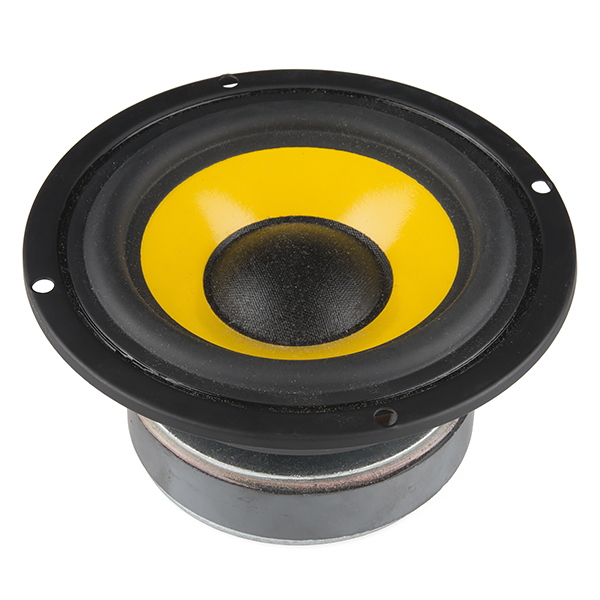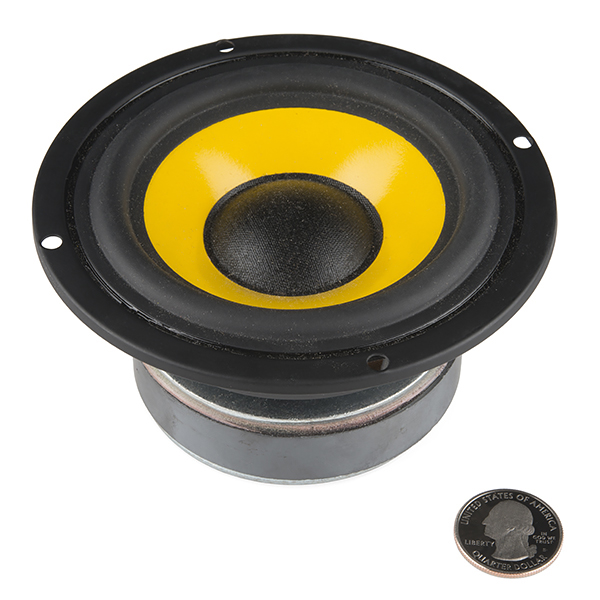Speaker - 4" Extended Range (25W, 8 ohm)
These are extended range 4" speakers, ideal for any medium sized application where you need a little more range than some of our smaller speakers. Power is supplied to each speaker via two solder tabs on the side. These speakers have a rated power handling of 25W (RMS) with a peak of 40W, a coil impedance of 8 Ohms, a sensitivity of 81 dB (1W/1M), and a frequency range of 71Hz-8kHz.
If you are looking for a cost-effective speaker with decent power handling, this is the right choice for you.
Speaker - 4" Extended Range (25W, 8 ohm) Product Help and Resources
Core Skill: Electrical Prototyping
If it requires power, you need to know how much, what all the pins do, and how to hook it up. You may need to reference datasheets, schematics, and know the ins and outs of electronics.
Skill Level: Rookie - You may be required to know a bit more about the component, such as orientation, or how to hook it up, in addition to power requirements. You will need to understand polarized components.
See all skill levels
Comments
Looking for answers to technical questions?
We welcome your comments and suggestions below. However, if you are looking for solutions to technical questions please see our Technical Assistance page.
Customer Reviews
No reviews yet.



What brand of this speaker?
Pssst... April 8th has past. Or perhaps your estimate should be 2015? :-)
We really hope not. Sorry, we thought we made an order that should have been here by the 8th, but the supplier didn't actually send it. We're trying to sort things out now. We'll get these back in stock as soon as we can (I need a few myself!).
Can someone provide a practical comparison between this speaker and COM-12050, which seems to have a much greater frequency response on the high end? The COM-12050 seems to have better overall range but how does that translate into real performance?
I'm looking to make a portable (<= 9v battery powered) mp3 speaker based on the LM386 chip in a sealed wood enclosure (which should help improve bass response). I will be trying 1 and 2 speaker builds. Also, if anyone can suggest a better IC than the LM386 that fits this profile, I'd love to hear what others are using. I'm aware of other IC's that need higher power rating (not suitable for battery) so please spare the general comments about your dislike for the LM386. Any comments or advice? Thank you!
Could I use one of these per channel on the STA540 kit?
How do speaker wattage ratings work? I have a 2watt d class amplifier that I really like and would love to hook it up to these speakers. Obviously there's no chance of overpowering the speaker, but will any sound be audible at all at 25w? The volume can go very very loud on 3 watt speakers, so for comfortable listening, will these be ok? Again, I have no idea how these ratings all work, would someone mind clearing this up for me? Thanks!
It'll sound great. The sound volume and quality have more to do with the coil ohms and cone size than the max wattage. We've found that even our 1W amplifiers sound really good (and surprisingly loud) on these. Enjoy!
Do you have Thiele/Small parameters for these speakers?
If you open the Datasheet, Rotate it, and zoom in on the 'notes' at the bottom of the page. The T/S Parameters are listed.
Revc = DC Resistance = 7.2Ω Fo = Fs = 71.347Hz Qms = 3.74 Qes = 0.719 Qts = 0.603 Vas = 2.084 Ltr Sd = 5.411 m² Md = 20.0g BL = 6.674 T·m no = 0.102 % SPL = 81.1 dB Cms = 501.249 µm/N Mms = 9.927 g Mmd = 9.698 mkg (mili-kilogram? in other words just gram) Krm = 1.845 Ω (mechanical ohm) Erm = 0.907 Kxm = 34.981 mH Exm = 0.652
Le is frequency dependent and given with the following equation: Le = Kxm · (ω ^ [Exm-1]) ; where ω = 2πf Le @ 1kHz (nominal value usually listed) ω = 2π · (1000) = 6283.1853 Le @ 1kHz = (34.981) · (6283.1853 ^ [0.652-1]) = 1.667 mH
Re is also frequency dependent and given with the following equation: Re = Revc + (Krm + ω ^ [Erm])
As an aside, to get the graph that is on the data sheet (Impedance graph), you just need to combine the effects of Re and Le. The reactance of Le is given X = Kxm · (ω ^ [Exm]) and the inductive reactance is 90 degrees out of phase with Re we will have to use some imaginary number j. Voice coil Impedance = Zvc = Re + j·X
Yeah more than you asked for, but its never a bad time to get a learn on.
Hello, when are you going to have these on stock?
not sure. it might be another couple of weeks. cyber monday depleted our stock quicker than expected. your best bet would be to use the 'notify me' button above.